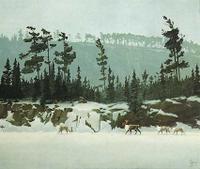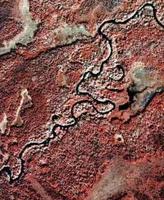The Jaques Generation

I recently attended a gathering at the Tamarack Nature Center in White Bear Lake to open their series on nature and art. Murray Olyphant lectured about his late friends Francis Lee and Florence Jaques. Lee was a noted wildlife artist, one of the best ever, and arguably Minnesota's greatest painter of any style. His wife Florence wrote a series of timeless travel and conservation books illustrated by her husband. They spent the last 20 years of their lives in the Twin Cities suburb of North Oaks.
I wrote a lengthy article about Lee and Florence Jaques earlier this year, and I have delved deep into their biographies. But this was my first time in a room with a bunch of their contemporaries--a good third of the crowd was octogenarians who, a generation younger than Lee and Florence, had clearly revered them. Olyphant himself is an accomplished portrait artist--though he prefers the term portrait "engineer"--and he provided plenty of insight into Lee's technique that my untrained eyes would never have caught. Among the many attendees were Art and Betty Hawkins, who first met Lee and Florence at the Delta marshes in Manitoba, a visit eloquently chronicled by Florence in Canadian Spring (1947).
This gathering represented to me the most important generations in American conservation, those who took the stand that our natural resources were not limitless in the face of America's growing prosperity. Without their diligence we would not have a BWCAW in Minnesota--it would likely be a series of reservoirs devoid of virgin forest, probably ringed with fly-in lodges and private vacation homes. Lee and Florence Jaques were acquainted with some of the greats of that movement: Sigurd Olson, Ernest Oberholzer, and William O. Douglas just to name a few. Those that remain among us have wonderful stories to tell, tales of journeys to the near north long before the ubiquity of paved roads and air travel; warnings about the suburban steamrolling of greenspace; distant memories of life's simplicity.
Events honoring the art of Lee Jaques are rare these days, and members
 of my generation and younger who recognize his name are few. But two institutions in Minnesota continue to celebrate his art: the Bell Museum of Natural History on the U of M's Minneapolis campus, and the Jaques Art Center in Aitkin, his hometown. Lee painted backdrops for many of the Bell's wildlife dioramas, and those installations alone are very much worth the price of admission. (I recently read that his background paintings in various museums total close to 30,000 square feet!) The art center in Aitkin honors its favorite son with exhibitions of his work and workshops on a variety of artistic skills for residents of the region. Lee was a pioneer in his ability to portray birds in flight, but his paintings are compelling for many reasons beyond mere technique. He mastered the Minnesota landscape with strokes that are both starkly realistic and startlingly beautiful.
of my generation and younger who recognize his name are few. But two institutions in Minnesota continue to celebrate his art: the Bell Museum of Natural History on the U of M's Minneapolis campus, and the Jaques Art Center in Aitkin, his hometown. Lee painted backdrops for many of the Bell's wildlife dioramas, and those installations alone are very much worth the price of admission. (I recently read that his background paintings in various museums total close to 30,000 square feet!) The art center in Aitkin honors its favorite son with exhibitions of his work and workshops on a variety of artistic skills for residents of the region. Lee was a pioneer in his ability to portray birds in flight, but his paintings are compelling for many reasons beyond mere technique. He mastered the Minnesota landscape with strokes that are both starkly realistic and startlingly beautiful.












